The Only Grain Salad Guide You’ll Ever Need (From a Chef)
I’ve spent a lot of my life in professional kitchens, and I’ve seen food trends come and go. Some are just flashes in the pan, but others stick around for a very simple reason: they’re just plain good. That one grain salad—you know the one, with the quinoa and chickpeas that seems to be everywhere online—is definitely in that second category. It’s popular because it nails that perfect balance of flavor, texture, and nutrition that honestly, we’re all looking for.
In this article
But here’s the thing. Most recipes just give you a list of ingredients and send you on your way. I want to do something different. I want to pull back the curtain and show you how a pro really builds this kind of dish. We’re not just mixing stuff in a bowl; we’re building a salad with intention, and you’ll learn the ‘why’ behind every single step. This is the kind of stuff that turns you from someone who just follows recipes into someone who really knows how to cook.
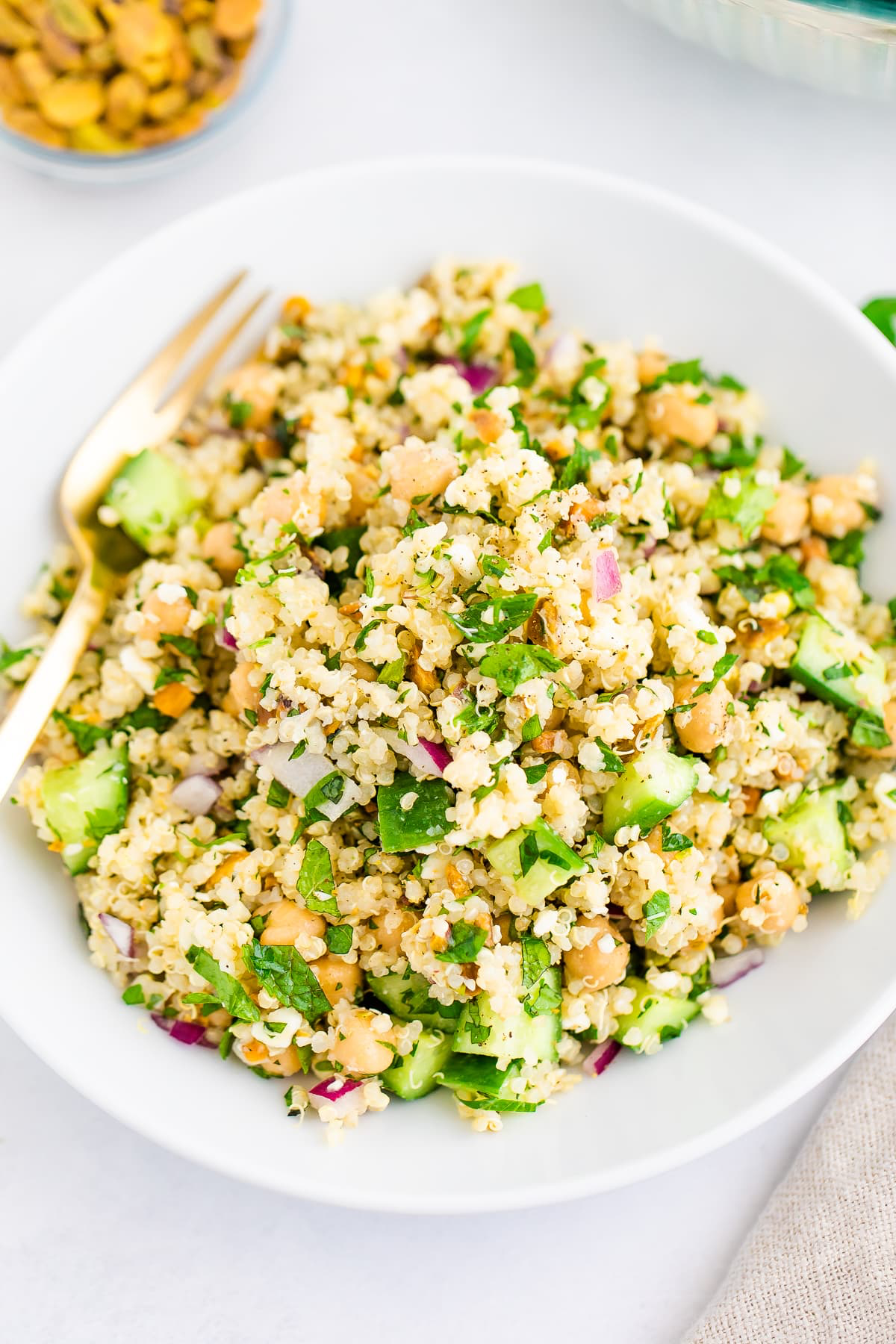
Quick Look: The Vitals
Before we dive in, here’s the basic rundown so you know what you’re getting into:
- Prep Time: About 25 minutes (mostly chopping)
- Cook & Cool Time: About 30-40 minutes (for the quinoa)
- Total Time: A little over an hour, but most of it is hands-off
- Servings: Makes about 6-8 side servings, or 4 solid lunch portions
- Cost: This can run you anywhere from $15 to $25 to make, depending heavily on the quality of your feta and olive oil. Totally worth it, in my opinion.
The Official Blueprint: Ingredients
Okay, let’s get down to brass tacks. Here is a solid starting point for a fantastic salad. Think of this as your base map before you start exploring.
For the Salad Base:
- 1 cup uncooked quinoa
- 1 can (15-ounce) chickpeas, rinsed and drained well
- 1 large English cucumber, finely diced (about 1 ½ cups)
- 1/2 small red onion, very finely diced (about 1/2 cup)
- 1 cup fresh parsley (flat-leaf is best), finely chopped
- 1/2 cup fresh mint leaves, finely chopped
- 1/2 cup toasted pistachios, roughly chopped
- 4-6 ounces of good feta cheese, crumbled from a block
For the Lemon Vinaigrette:

- 1/2 cup good quality extra virgin olive oil
- 1/4 cup fresh lemon juice (that’s usually 1-2 juicy lemons)
- 1 teaspoon fine sea salt (plus more for the quinoa water)
- 1/2 teaspoon freshly ground black pepper
Let’s Talk Foundations: The ‘Why’ Behind the ‘What’
A great salad isn’t a random jumble; it’s a construction project where every piece has a job. Once you get this part, you can build anything.
Choosing Your Grain
The grain is the heart of the salad, and your choice here makes a huge difference. While quinoa is the popular kid on the block, you’ve got options.
- Quinoa: This is technically a seed, and it’s fantastic because it’s a complete protein. It cooks up to be light and fluffy. A little heads-up: you HAVE to rinse it first. It’s coated in something called saponin, which is naturally bitter and soapy. A good rinse in a fine-mesh sieve for a minute under cold water solves this completely. It cooks in about 15 minutes.
- Bulgur Wheat: This is what you’ll find in more traditional Middle Eastern parsley salads. It’s basically par-cooked cracked wheat, so it’s super fast—you just need to rehydrate it in hot water. It has a wonderful chew and a nutty, earthy flavor. If you use this, you’re making something closer to a classic tabbouleh.
- Farro: My personal favorite for a heartier salad. Farro is an ancient grain with a substantial, satisfying chew that holds up for days. It takes a bit longer to cook, usually around 25-30 minutes, but it’s worth it.
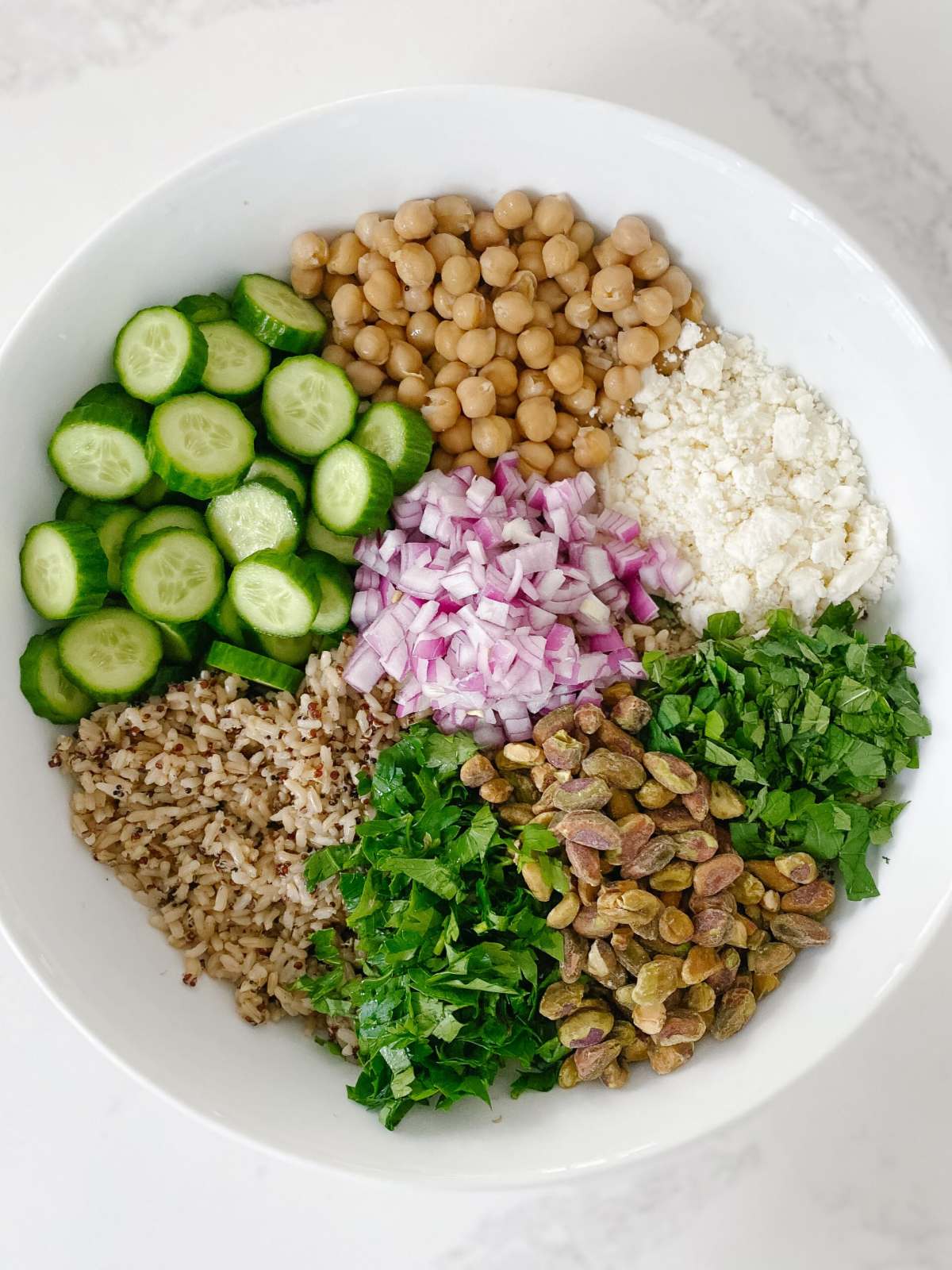
The Vinaigrette is Everything
The dressing is the soul of the salad. It’s what brings everyone together. A classic vinaigrette ratio is 3 parts oil to 1 part acid, but for a bright, fresh salad like this, I lean a little sharper, more like 2 parts oil to 1 part acid. So, for a batch this size, I’ll start with 1/2 cup of good olive oil and 1/4 cup of fresh lemon juice. Always use the fresh stuff—that bottled lemon juice has a weird metallic taste that will tank your whole salad. The acid in the lemon also mellows out the bite of the raw red onion, which is a nice little bonus.
The Game Plan: Pro Techniques for a Flawless Salad
In a pro kitchen, it’s all about technique. These are the little habits that guarantee your salad is amazing every single time.
Nailing the Quinoa (No Mush Allowed!)
This is where most people go wrong. Waterlogged quinoa is a salad-killer. Here’s the foolproof method:
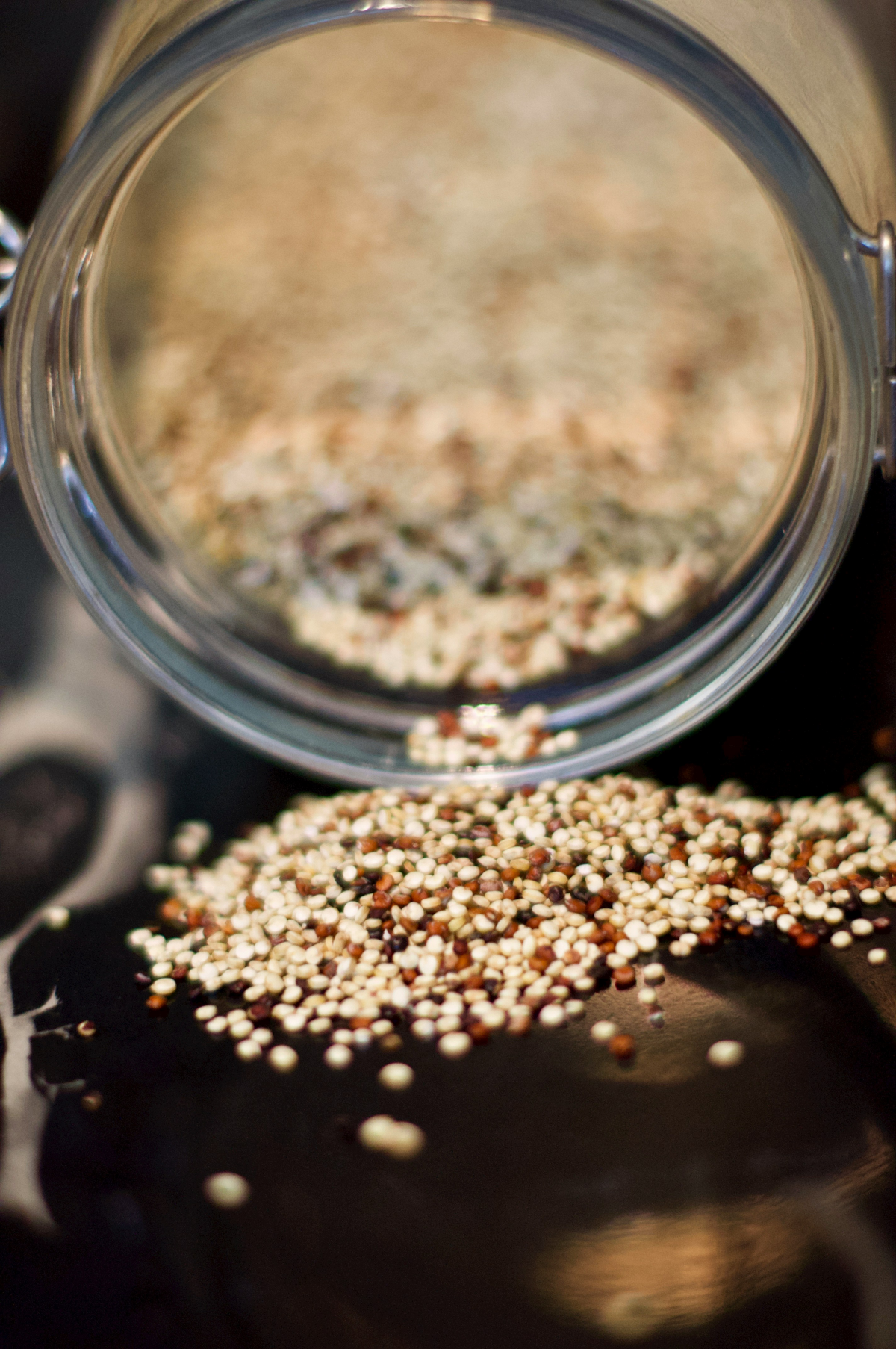
- Rinse it. Seriously. One full minute under cold water in a sieve.
- Toast it. This is optional, but it makes a huge difference. Throw the rinsed, drained quinoa into a dry pot over medium heat and stir it for a couple of minutes until it smells nutty. It deepens the flavor like crazy.
- Cook it right. Add 1.75 cups of water (NOT the 2 cups on the box) and a good pinch of salt (about ½ teaspoon). Bring it to a boil, then immediately drop the heat to the absolute lowest setting, cover it tight, and set a timer for 15 minutes. Don’t you dare lift that lid!
- Let it rest. This is the most important step. After 15 minutes, take the pot off the heat but leave the lid on. Let it stand for another 10 minutes. This lets the grains steam and separate perfectly.
- Cool it completely. Fluff the quinoa with a fork and spread it on a baking sheet to cool down fast. If you add warm quinoa to your salad, you’ll wilt the herbs and make everything soggy. Non-negotiable.
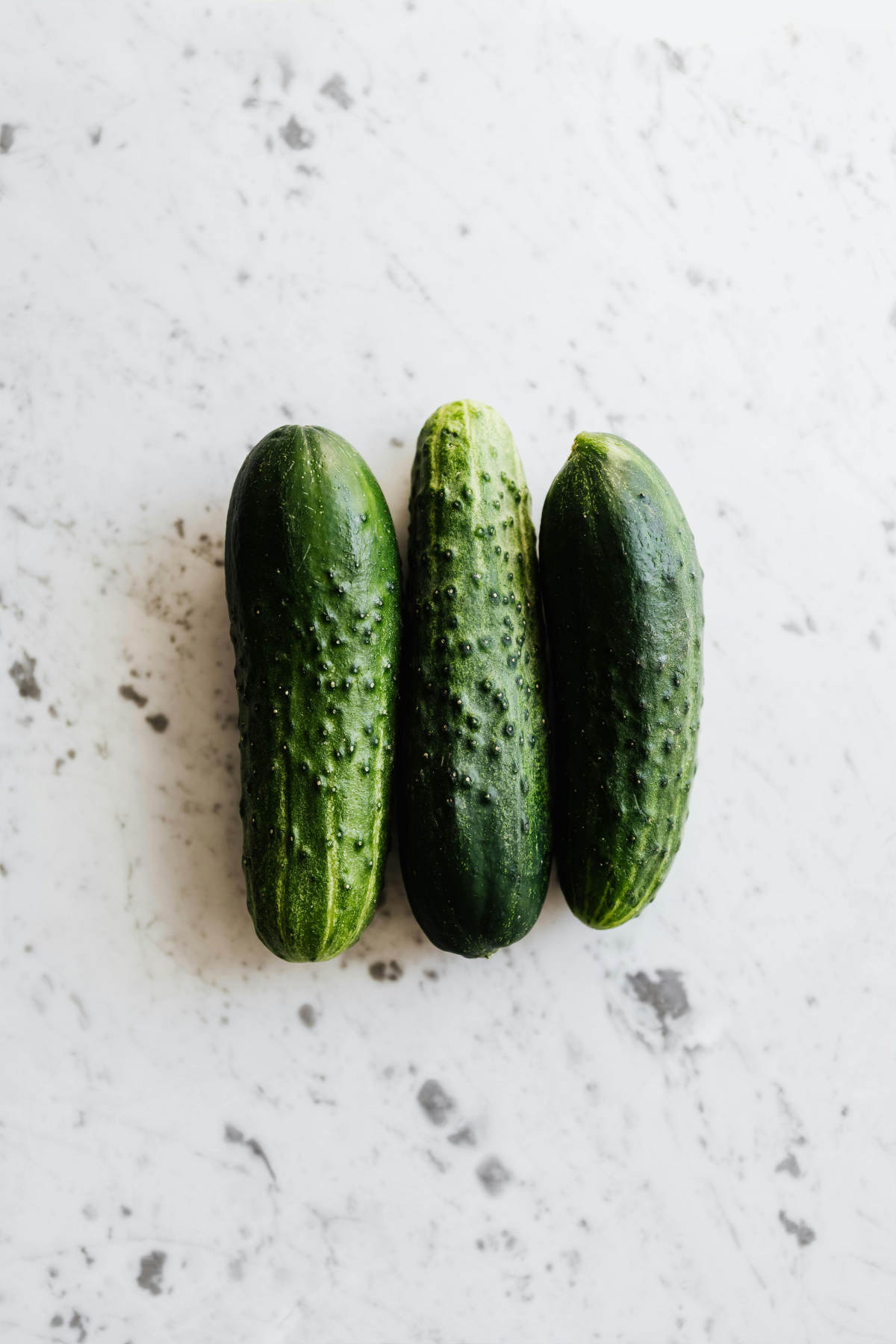
Prep Like a Pro (Mise en Place)
“Mise en place” just means getting all your ingredients ready before you start mixing. For a salad, it’s everything.
A quick tip on the onion: If you’re sensitive to raw onion, dice it finely and let it soak in a bowl of cold water for 10 minutes. Drain it well, and voilà, the harsh bite is gone.
Heads up! If you do only one thing from this guide, make it this: Stop buying pre-crumbled feta. That stuff is coated in powders to keep it from clumping and has a dry, sad texture. Buy a block of feta that’s packed in brine. It’s creamier, tangier, and a million times better. You can usually find a good block for between $5 and $8 at most grocery stores.
The Art of Assembly
The order you mix things in matters. A lot. I’ll never forget the time I had to make a giant batch of this for a catering gig and I dressed it all at once, way too early. I came back an hour later to five pounds of wilted, sad-looking parsley. My chef was… not pleased. It’s a mistake you only make once.

- Dress the Base: In your biggest bowl, combine the completely cooled quinoa, the rinsed chickpeas, and the finely diced red onion. Pour about two-thirds of your dressing over this and stir well. Let it hang out for at least 15 minutes to soak up all that flavor.
- Add the Sturdy Veg: Now, add the diced cucumber and toasted pistachios. Give it another good toss.
- Fold in the Delicates: Right before you serve, gently fold in the fresh herbs (parsley and mint) and the crumbled feta. Add the rest of the dressing if it looks like it needs it. Waiting until the last second keeps the herbs bright green and the feta from turning to mush.
Making It Your Own: Riffs and Swaps
Once you understand the basic formula (grain + legume + crunchy thing + fresh herbs + killer dressing), you can go anywhere with it.
- Go Southwest: Swap the parsley for cilantro, the pistachios for toasted pumpkin seeds (pepitas), and the feta for cotija. Add some black beans and corn. Use lime juice instead of lemon in your dressing and add a pinch of cumin.
- Try an Autumn Vibe: Use farro instead of quinoa. Add some roasted butternut squash cubes and dried cranberries. Swap the pistachios for toasted pecans and use a maple-dijon vinaigrette. Delicious.
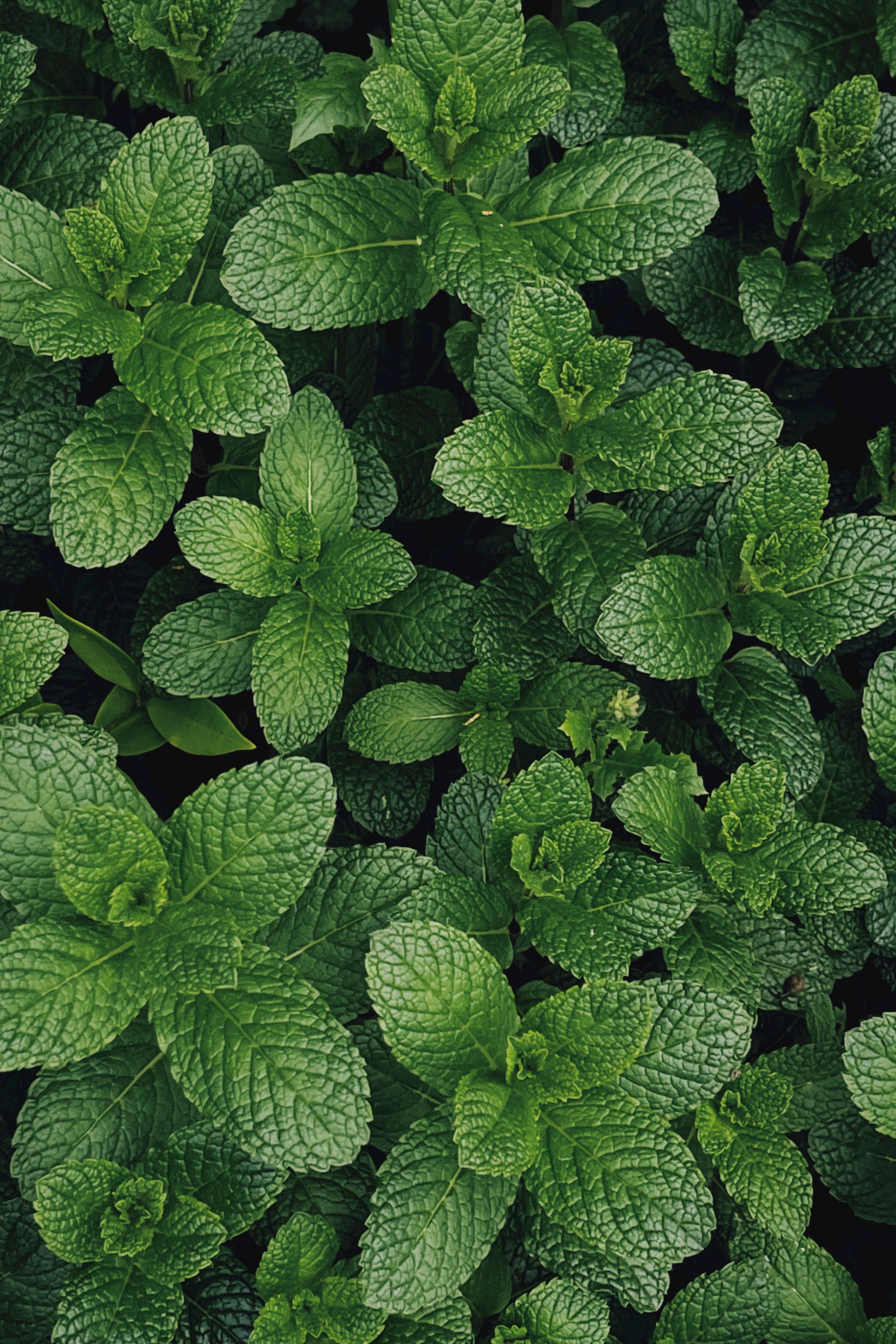
Practical Advice for Real Life
A good recipe should work for your life, whether that’s a party side dish or your lunch for the week.
Meal Prepping This Salad the Right Way
This salad is a meal prep champion, but you can’t just mix it all together on Sunday and expect it to be good on Thursday. It’ll be a soggy mess. Here’s how the pros do it:
Keep your components separate! Cook the quinoa and store it in one container. Mix the chickpeas and onion in with it. Make the dressing and keep it in a small jar. Chop the cucumber and store it in a separate container, maybe with a paper towel to absorb moisture. Keep the nuts and feta separate, too. Each day, just scoop a bit of everything into a bowl, add your herbs (chop them fresh if you can!), and toss. It takes two minutes and tastes like you just made it.
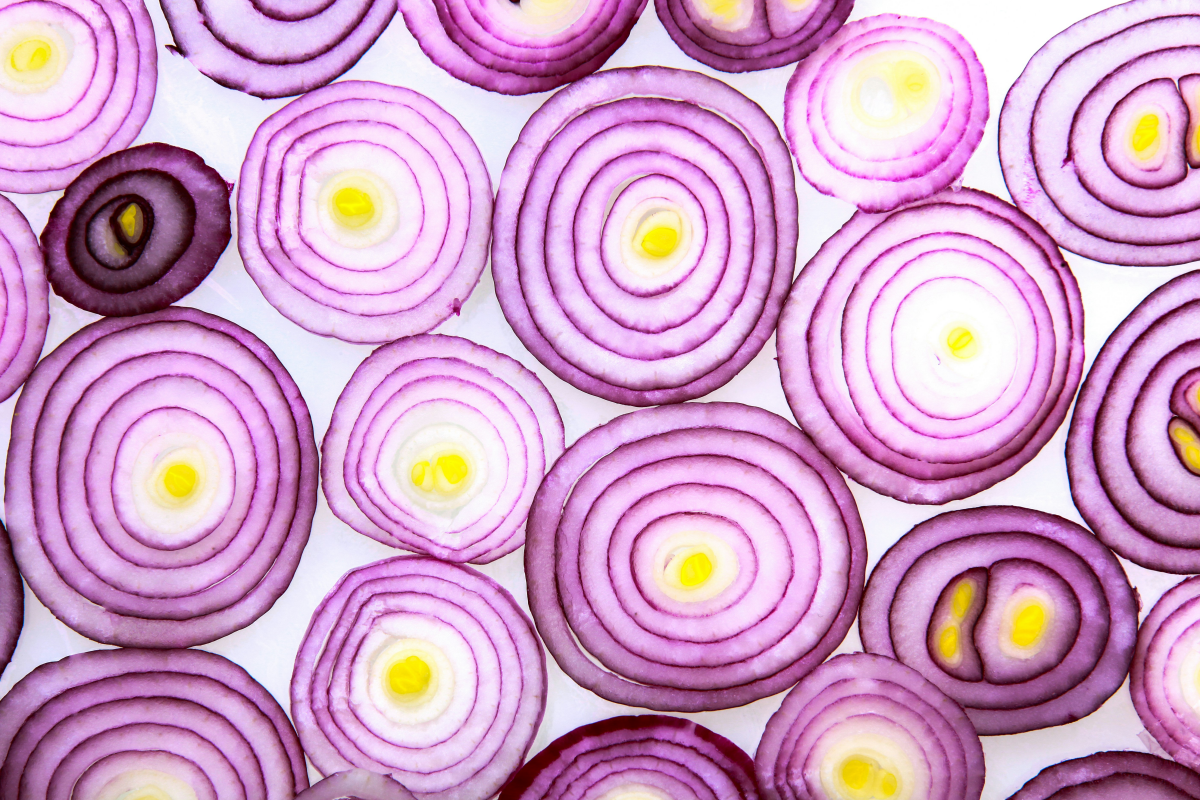
Troubleshooting 101
- Is your salad watery? You probably either didn’t cool your quinoa enough, or your cucumber released all its water. Next time, make sure the quinoa is bone dry and cool. You can also salt your diced cucumber and let it sit in a colander for 20 minutes to draw out water before adding it.
- Does it taste bland? It almost always needs more salt or acid. Cold food needs more seasoning than warm food. Taste it straight from the fridge and add another pinch of salt and a squeeze of lemon until the flavors pop.
- Are your herbs dark and wilted? You either added them too early, or your knife is too dull. A sharp knife slices herbs cleanly without bruising them. And remember my sad parsley story—add them at the very end!
So there you have it. This salad is more than just a recipe; it’s a method. Once you master the techniques, you can move beyond just following steps and start creating with confidence. And that’s a skill that will last a lot longer than any food trend.

Galerie d’inspiration
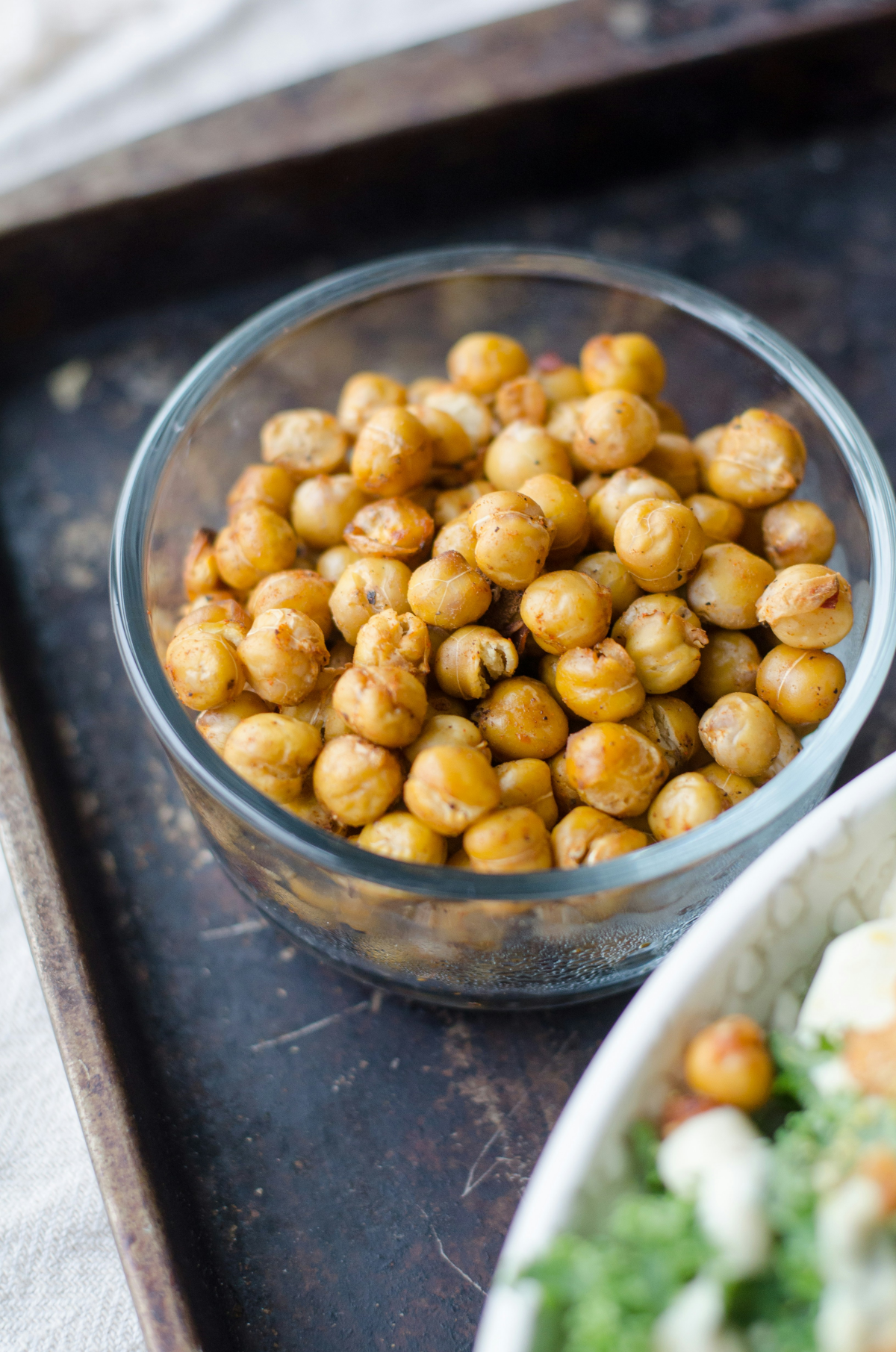
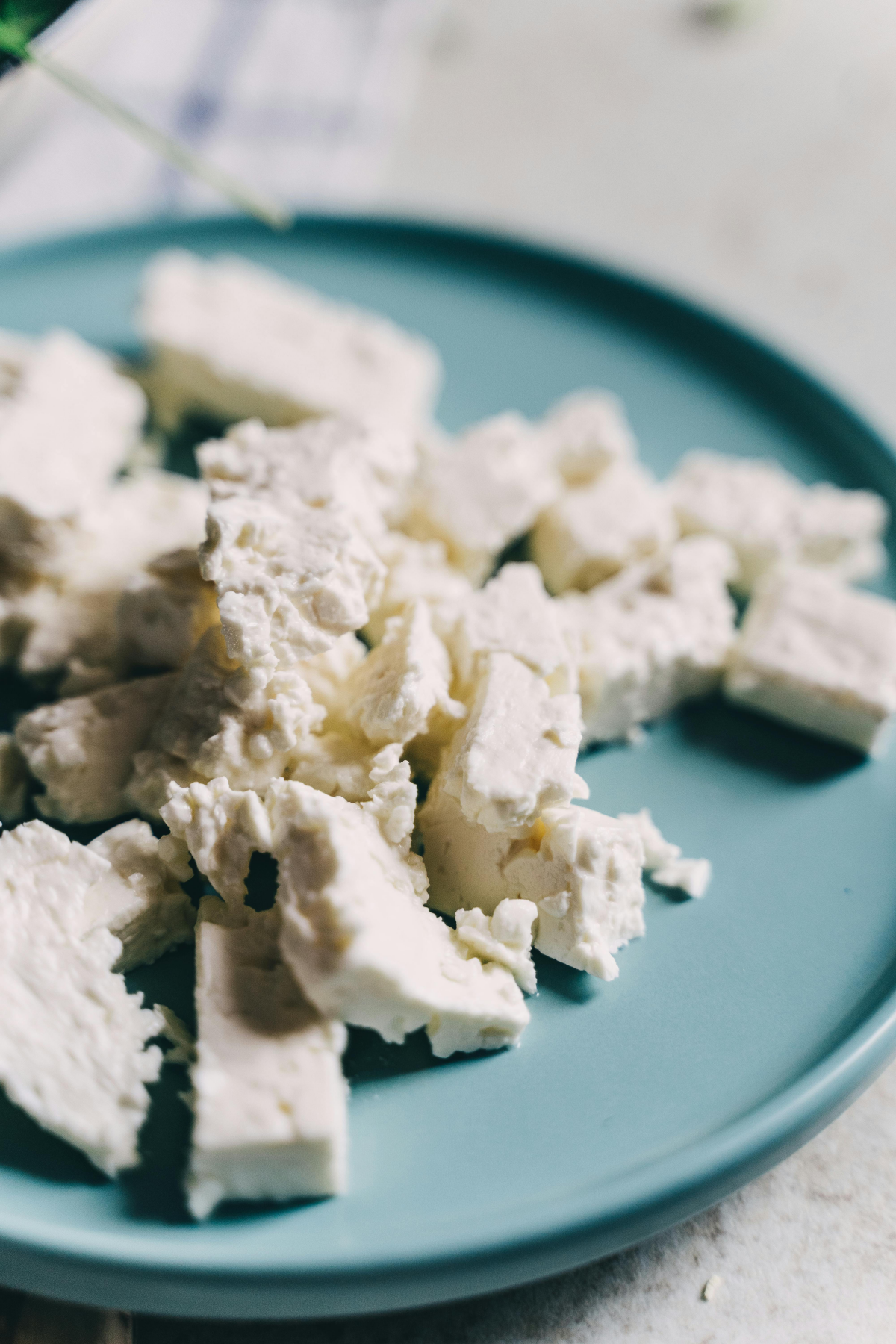
Tired of mushy, disappointing quinoa?
The secret is threefold. First, always rinse your quinoa in a fine-mesh sieve to remove its natural bitter coating, saponin. Second, forget the common 1:2 grain-to-water ratio. For a fluffier texture, use 1.75 cups of water for every 1 cup of quinoa. Finally, once the water is absorbed, remove the pot from the heat, cover it, and let it steam for 5-10 minutes. Only then should you fluff it with a fork. This ensures each grain is perfectly distinct and ready to absorb the vinaigrette without turning to mush.
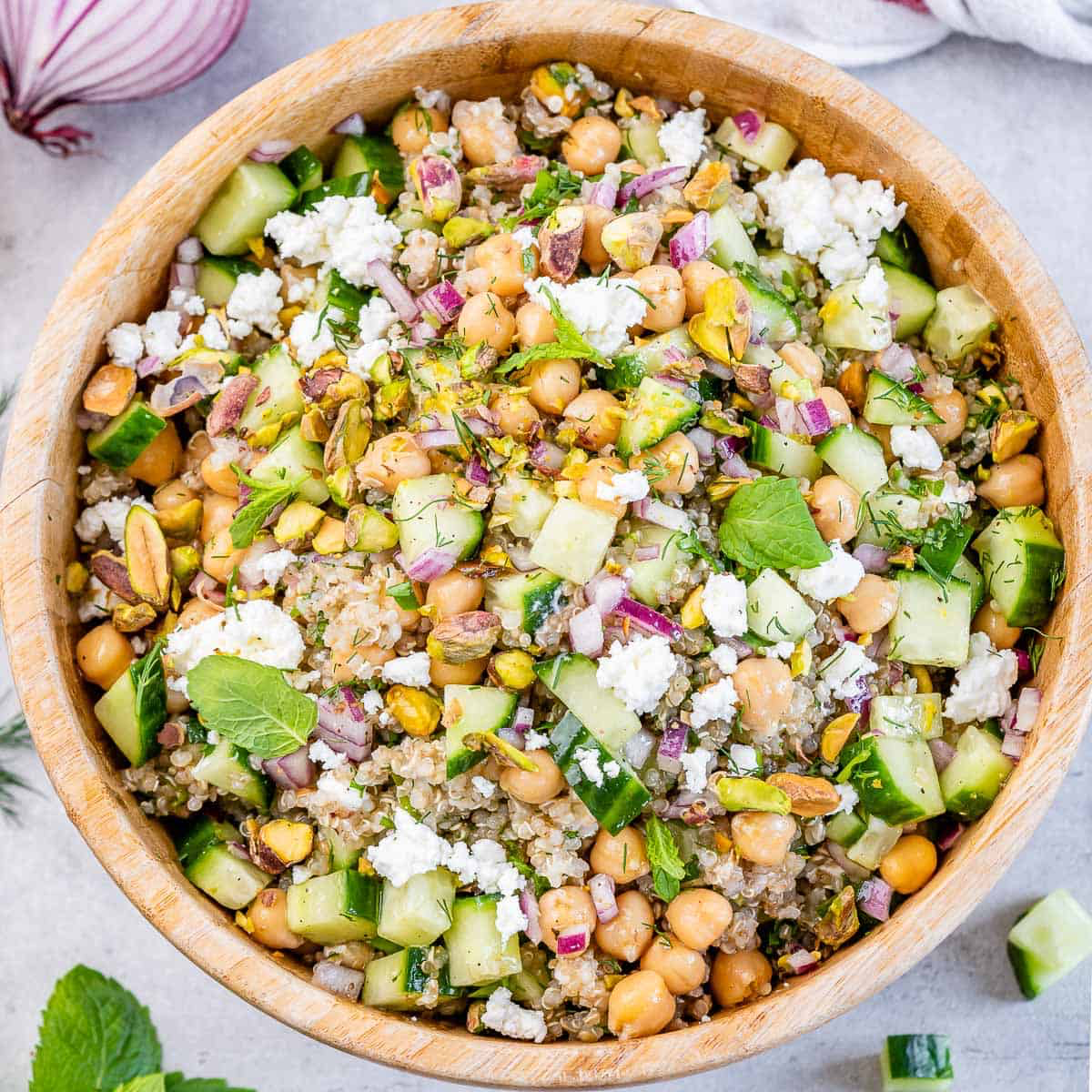
Block Feta: Sold in a brine, it’s creamier, tangier, and has a more complex flavor. You crumble it yourself, resulting in wonderfully irregular pieces. Brands like Dodoni or Mt. Vikos offer an authentic Greek experience.
Pre-crumbled Feta: Convenient, but often drier and coated with anti-caking agents (like cellulose) that can dull its taste and prevent it from melting beautifully into the salad.
For the best texture and taste, buying the block is a small step that makes a huge difference.

The beauty of this salad is its versatility. Think of the quinoa as just one possible canvas. To change the entire experience, try swapping the grain:
- Farro: Offers a substantial, satisfying chew and a nutty flavor that pairs wonderfully with the pistachios.
- Freekeh: This roasted young wheat has a unique smoky taste that adds incredible depth.
- Pearl Couscous: For a softer, pasta-like texture with delightful little spheres that capture the dressing.
- Bulgur Wheat: The classic base for tabbouleh, it’s quick-cooking and light, making the salad feel even fresher.
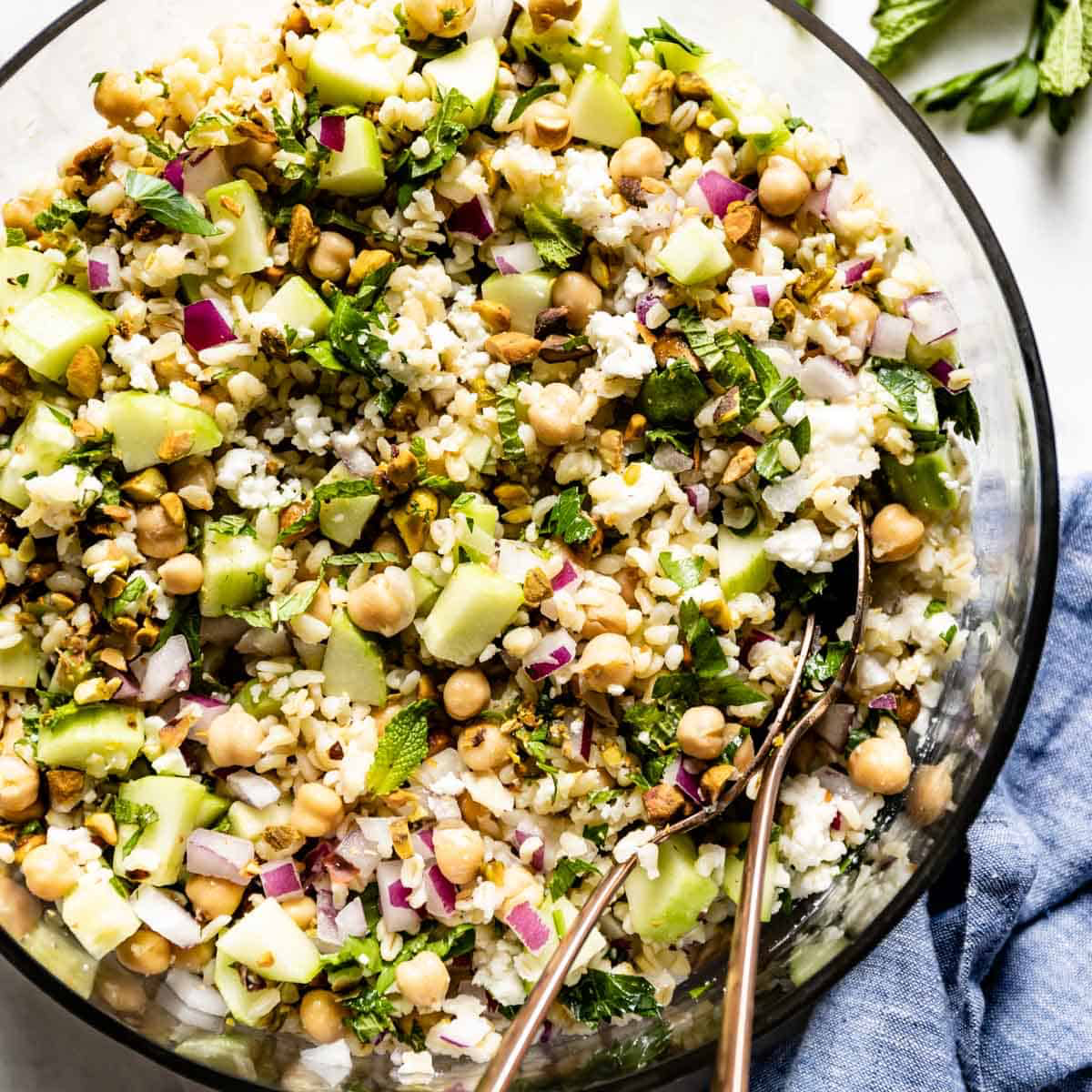
A 2021 survey found that Americans spend, on average, over $3,000 a year on lunch.
Making a large batch of this grain salad on a Sunday is more than just a culinary task; it’s a smart financial strategy. It provides 4-5 delicious, ready-to-go lunches for the week, saving you time and money. By keeping the dressing separate until you serve, the ingredients stay crisp and fresh for days. It’s the ultimate ‘meal prep’ win for both your wallet and your well-being.
More than just a list of ingredients, a great salad is a symphony of textures. Notice the delightful contrast with every bite: the soft pop of the chickpeas, the firm crunch of the fresh cucumber, the nutty snap of the pistachios, and the creamy, salty counterpoint of the feta. It’s this multi-layered experience that makes it so satisfying and keeps you coming back for more.










